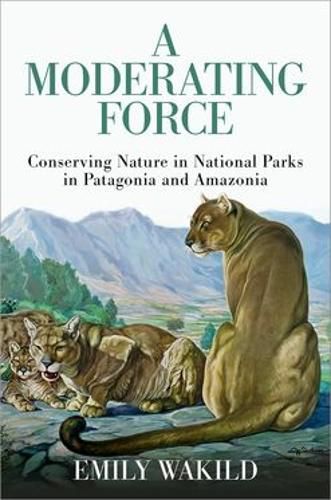Readings Newsletter
Become a Readings Member to make your shopping experience even easier.
Sign in or sign up for free!
You’re not far away from qualifying for FREE standard shipping within Australia
You’ve qualified for FREE standard shipping within Australia
The cart is loading…






Over the past century, landscapes across South American fundamentally changed. As forests were felled, cities and highways built, and agricultural land was managed, national governments set aside protected landscapes in certain charismatic places. These areas- which include some of the most iconic nature reserves on the planet, from Amazonian forests to Patagonian ice fields. -have direct bearing on the world's climate system, the regulation of carbon in the atmosphere, and the protection of species. They are home to hundreds of thousands of Native peoples and millions of mixed-race and European settlers. Today, more than a quarter of South America lies within conservation areas.
In A Moderating Force, award-winning Latin American environmental historian Emily Wakild relates a transnational comparative history of two paradigmatic regions-the temperate southern third of South America known as Patagonia and the tropical expanse known as Amazonia. Wakild traces the development of national parks in Argentina, Chile, Peru, and Brazil from the nineteenth to the twenty-first century, explaining the historical processes that led to nature conservation at the national level. She explores the many different perspectives and priorities that contribute to deciding what makes the "best" park and for whom- wild animals, Indigenous residents, national heritage, tourism, or climate resiliency. As the parks were built, they served as a moderating force softening national power by imposing compromises on diverse landscapes. From these sites, politically powerful, scientifically trained, and dedicated resident conservationists navigated new professional platforms and launched studies of flora and fauna that prioritized expertise to be gained in the field. This wide-ranging study sheds new light on exploration, state-making, scientific practice, economic development, and nature conservation in the past to inform what this history means for our future.
$9.00 standard shipping within Australia
FREE standard shipping within Australia for orders over $100.00
Express & International shipping calculated at checkout
Stock availability can be subject to change without notice. We recommend calling the shop or contacting our online team to check availability of low stock items. Please see our Shopping Online page for more details.
Over the past century, landscapes across South American fundamentally changed. As forests were felled, cities and highways built, and agricultural land was managed, national governments set aside protected landscapes in certain charismatic places. These areas- which include some of the most iconic nature reserves on the planet, from Amazonian forests to Patagonian ice fields. -have direct bearing on the world's climate system, the regulation of carbon in the atmosphere, and the protection of species. They are home to hundreds of thousands of Native peoples and millions of mixed-race and European settlers. Today, more than a quarter of South America lies within conservation areas.
In A Moderating Force, award-winning Latin American environmental historian Emily Wakild relates a transnational comparative history of two paradigmatic regions-the temperate southern third of South America known as Patagonia and the tropical expanse known as Amazonia. Wakild traces the development of national parks in Argentina, Chile, Peru, and Brazil from the nineteenth to the twenty-first century, explaining the historical processes that led to nature conservation at the national level. She explores the many different perspectives and priorities that contribute to deciding what makes the "best" park and for whom- wild animals, Indigenous residents, national heritage, tourism, or climate resiliency. As the parks were built, they served as a moderating force softening national power by imposing compromises on diverse landscapes. From these sites, politically powerful, scientifically trained, and dedicated resident conservationists navigated new professional platforms and launched studies of flora and fauna that prioritized expertise to be gained in the field. This wide-ranging study sheds new light on exploration, state-making, scientific practice, economic development, and nature conservation in the past to inform what this history means for our future.